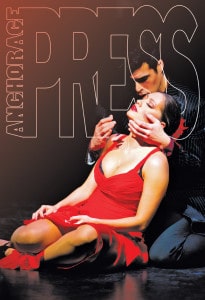Backstage at the Performing Arts Center is a labyrinth of hallways, but last Saturday a clue to the correct door to the Sydney Laurence theater comes in the form of Luis Orozco’s rich baritone going through the scales from behind a dressing room door.
The intimate and empty theater has been transformed into a milonga. There’s a wooden bar up on the stage, a grand piano, seats for other musicians, a smattering of candlelit tables and chandeliers dangling from the ceiling.
The occasion is a lighting run-through for the upcoming production of Maria de Buenos Aires, Anchorage Opera’s second show of the season, which brings the heat of Argentina to Anchorage from January 21 through 24.
Tony-winning director and choreographer Adam Cates is unassuming and gracious as he and the crew work through the rather tedious process of noting lighting cues. The cast is patient as they run through the scenes, but technical becomes magical when Cates has them sing and dance a few numbers; the music of this tango-opera is haunting and infectious. The performances, even in this informal setting, are flawless.
Apart from the three seasoned principals—Catalina Cuervo as Maria, Luis Alejandro Orozco as El Payador, and Milton Loayza as El Duende—the six supporting dancers are local students from Anchorage Ballet, and they’ve impressed Cates.
“They learned the score in four days, I basically vomited the show on them,” he says. “I’ve never set an opera this fast.”
The fact that they are ballet dancers taking on a tango opera is somewhat intentional for Cates’ version of the Astor Piazzolla work, which he describes as more of a tango club floor show and a series of vignettes than a linear interpretation of a story full of Catholic imagery and surrealism.
The libretto, written by Horacio Ferrer and narrated by El Duende, is sheer poetry, Cates says, and at first glance the plotline was hard for him to get his head around.
“When I was first approached to stage Maria, I picked up the libretto and read a story about a witch who conjures up a woman named Maria. She is born on a day God was drunk, raised in the slums and then becomes a prostitute, seduces everyone in the bar and dies. Then she sits up and cries, wanders through the city as a shadow, encounters a circus and a shrink, gets angry, becomes a virgin and then has a baby which might actually be her … The end,” Cates says with a bewildered smile.
His production allows the power of music to take on a starring role. Each song is portrayed as its own vignette, with the surreal concept of Maria embodying tango and the city itself as more of a backing vocal.
As the afternoon progresses, Cates and lighting director Cedar Cussins work together on achieving the desired effects, playing with darkness and light at different areas of the stage to suit the production’s numerous mood swings.
One scene has Cuervo standing on an invisible platform (substituted by a chair for this rehearsal) and once the lighting’s right it gives the illusion that she’s floating in the blackness. It’s breathtaking.
And Cuervo is again breathtaking the following day when she and principal castmates join Cates and conductor Douglas Kinney Frost at “Take One,” a friendraiser for the Opera in which opera-lovers enjoy a reception, performances and a panel discussion of the show which debuts Thursday.
Kinney Frost acts as moderator. He and the three principals all worked together on the well-received 2014 Syracuse production of Maria which caught the eye of Anchorage Opera’s Reed Smith and Judy Berry. Maria’s edginess was something Anchorage audiences were ready for, Berry says, and it fit right in with the “Season of Passion” theme, which debuted with Carmen in October and will conclude with The Mikado in April.
“Building new opera audiences while appealing to our already die-hard fans is crucial to the future of our art form,” says Smith. “One of the goals of Anchorage Opera is to introduce our patrons to the variety the opera genre provides. Maria does just that and we intend to do so in the future as well.”
In fact, Cuervo and the achingly handsome Orozco have performed Maria more than anyone else in the world, Kinney Frost says, and their love for the music, characters and Maria’s story—synonymous with that of tango itself—is obvious.
The Columbian-born Cuervo—clad in a low cut red ensemble and full makeup—is ravishing, and she knows it. “This is just so you get used to seeing a lot of skin,” she tells her audience with a broad smile as she steps up to sing an aria. “You’re going to feel the heat and warmth from us, the sweat of living this experience that is completely different from the weather here.” With the first note that passes her crimson lips she owns the room. She’s even got an older gentleman blowing kisses at her.
Cuervo’s voice is beautiful and rich, an octave lower than her regular soprano. Cuervo admits she sings tango using her chest voice, which she never knew she had until her first time singing Maria, a role she has come to embody and embrace.
Watching her performance with particular fascination is Cristabel, a soft-spoken, 16-year-old budding classical singer taking an interest in an artform that may seem irrelevant to many of her generation. “Singing opera has such power,” Cuervo tells a rapt Cristabel near the close of the event, posing for a photo with the teenager. “There’s no comparison. The experience is mind-blowing.”
Smith and Berry couldn’t have been more pleased by the success of Take One. “There’s nothing that dispels the caricature stereotype of an opera singer better than getting to know them at Take One events; and there’s nothing quite so gratifying as watching a high school student who came to Take One: Maria so engaged by the program and how her face lit up when and our leading lady Catalina Cuervo joined her at her table at the reception following the program,” says Smith. “That impacts the next generation in a way nothing else can.”
Cuervo and operas like Maria—written in 1968 and first performed in the US in the ‘90s—may change the demographics of opera audiences. There’s nothing about Maria that even hints at the Wagnerian stuffiness that puts many to sleep, no fat lady singing at the finale.
In contrast, Maria is alive and hypnotic, with music and imagery that transports the audience out of the darkness and cold of January, and into a world of poetry, sexuality, beauty and fire. This production of Maria de Buenos Aires is well-worth the journey; let yourself be seduced. Read more
Photo by Doug Wonders
